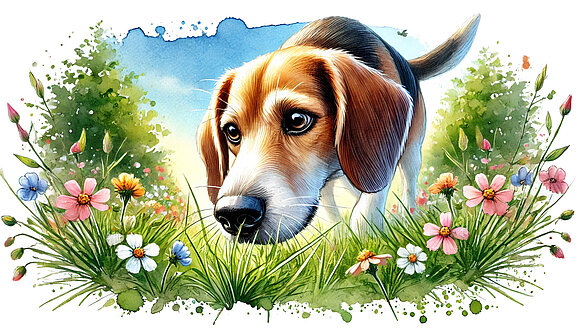The wonderful world of the dog's snout: All about the nose

The anatomy of a dog's snout
A dog's nose is far more than just a cute feature on its face. It is a highly complex and sensitive organ. Here are some important points about the anatomy of the dog's snout:
Olfactory cells and their incredible number
A human has around 5 million olfactory cells. By comparison, a dog has between 220 million and 300 million of these cells, depending on the breed. This enormous number of olfactory cells allows dogs to distinguish odors in incredible detail.
The Jacobson's organ
In addition to the olfactory cells, dogs have an additional olfactory organ, the Jacobson's organ or vomeronasal organ. This organ is located in the upper palate and is particularly important for recognizing pheromones. It helps dogs to perceive social information such as the reproductive status of another dog.
How dogs experience the world through their nose
The importance of the sense of smell
For dogs, the sense of smell is the most important of their five senses. While humans are mainly visual beings, dogs experience their world primarily through their nose. They can not only perceive odors, but also "see" them - they can form a picture of the environment based on the smells they perceive.
Odor memories
Dogs are amazingly good at remembering smells. An odor that they have perceived once can remain in their memory for years. This explains why your dog gets excited when he sniffs a place you visited a long time ago.
The role in finding food and communication
Scent plays a crucial role in finding food and communication between dogs. Wild dogs or wolves rely heavily on their sense of smell to track down prey. Dogs also communicate in everyday life using scent marks, which they use to mark their territory or to send messages to other dogs.
Why dogs sniff in certain places
The marking of territories
If your dog sniffs particularly intensely in a certain spot, it could be that another dog has marked its territory there. By sniffing, your dog can find out a lot of information about the "sender" of this message, such as gender, age and even health status.
The search for social information
Dogs also sniff the rear ends of other dogs intensively. This may seem unpleasant for us humans, but for dogs it is an important form of greeting and getting to know each other. This gives them important social information about the other dog.
The super noses of sniffer dogs
Training and areas of use
Sniffer dogs are specially trained dogs that use their excellent smelling abilities to help people. They are used in various areas, such as searching for missing persons, drugs, explosives or even diseases such as cancer.
Incredible success rate
The success rate of sniffer dogs is impressive. They can detect substances in minute quantities and have proven to be indispensable in many operations. Their work shows just how powerful a dog's nose really is.
A true wonder of nature
Your dog's nose is more than just a sniffing tool. It's a true miracle of nature that helps him experience the world in ways that are almost unimaginable to us humans. By understanding how important and powerful your dog's nose is, you can better understand him and better fulfill his needs.
So, the next time your dog investigates a particularly exciting spot on the ground, take a moment to appreciate this wonder of nature - and let him sniff a little longer!